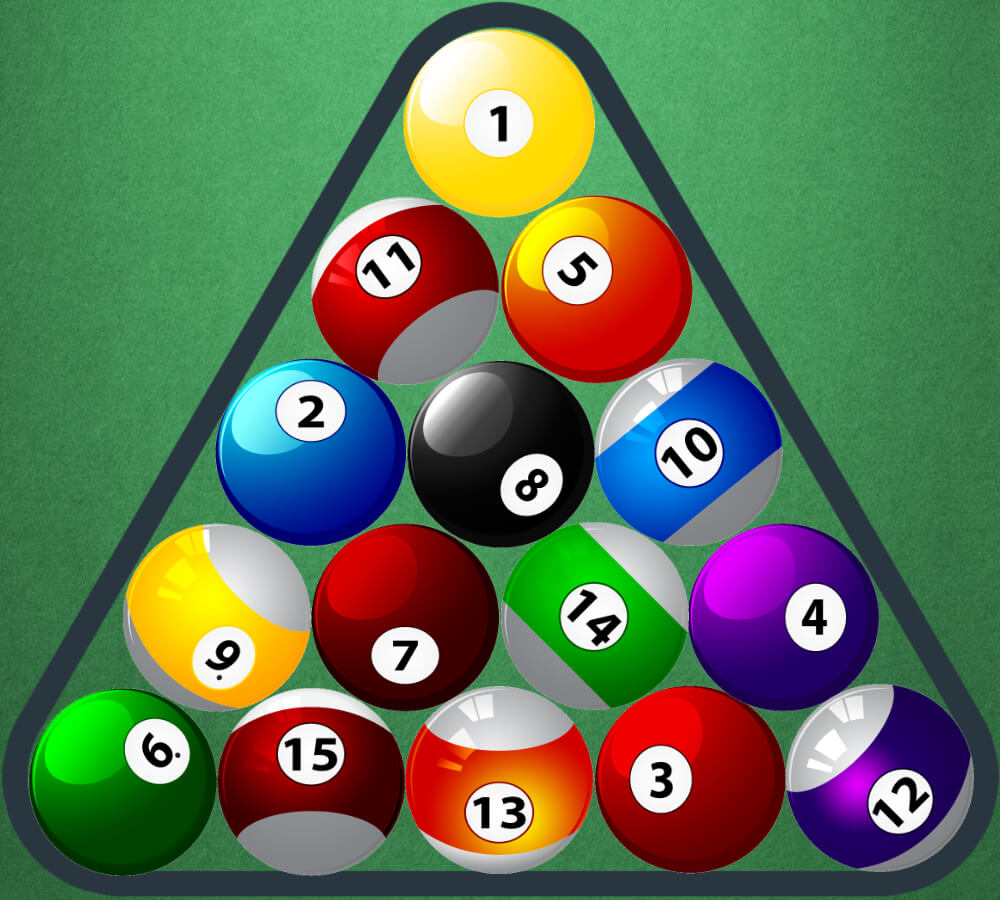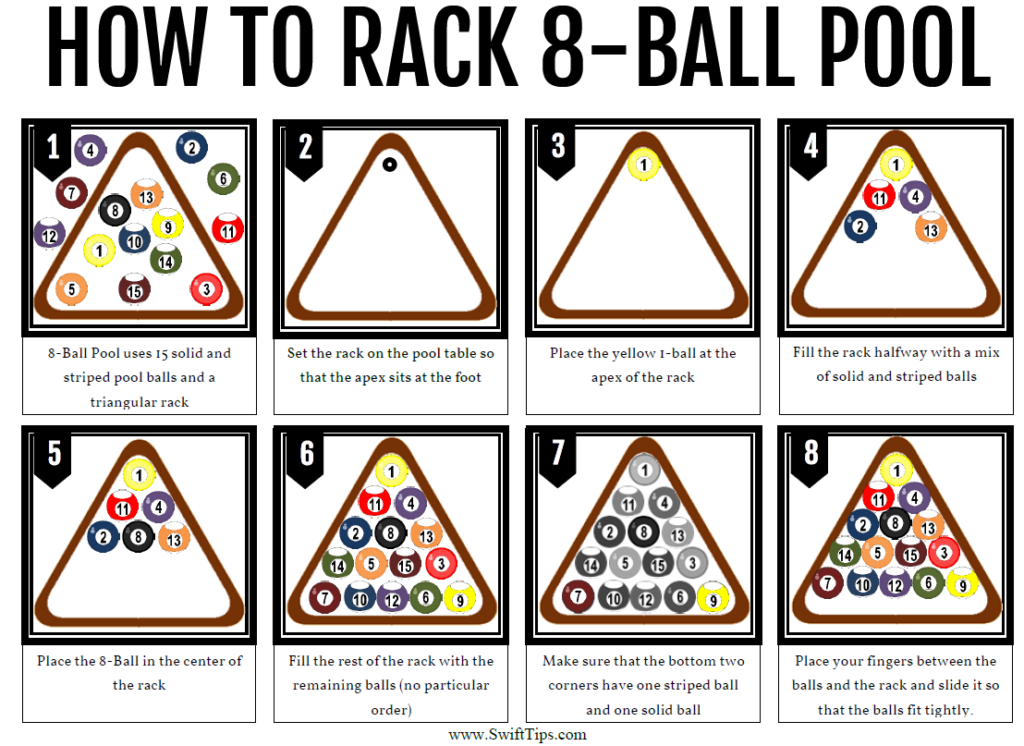Ever wondered if there's more to setting up a pool game than just scattering the balls? The truth is, mastering the art of racking is absolutely essential for a fair, competitive, and genuinely enjoyable game of pool.
Indeed, the seemingly simple act of "racking," or precisely arranging the billiard balls before the break, holds the key to unlocking a game's full potential. Its the foundation upon which every shot, every strategy, and every victory is built. Without a proper rack, the initial break becomes a lottery, favoring luck over skill and potentially skewing the entire match. Whether you're a seasoned pool shark or a casual player, understanding and executing a tight, well-formed rack is paramount. It guarantees that all players start on an even playing field, maximizing both challenge and excitement. The way you position those fifteen balls can significantly influence the spread, the angles, and ultimately, the outcome of the game, transforming a haphazard setup into a strategic battleground. Its more than just arranging spheres; it's about crafting opportunity and ensuring fairness.
| Aspect | Details |
|---|---|
| Name | N/A (Focus is on the process, not a specific person) |
| Profession | Pool/Billiard Player (General) |
| Career Highlights | Consistent, Fair Gameplay Through Proper Racking Techniques |
| Key Skills | Precision, Attention to Detail, Knowledge of Pool Rules |
| Website | Billiards Congress of America (BCA) |
Racking in pool, billiards, or snooker is the meticulous process of arranging the object balls into a specific formation before the start of the game. This ensures that the initial break is as equitable as possible. In most standard pool games, this involves using a triangular rack to create a tight, compact arrangement of fifteen balls. The primary goal is to eliminate any gaps between the balls, as this directly affects the energy transfer during the break and influences the subsequent ball spread. A loose rack leads to unpredictable breaks, potentially favoring one player over another. Conversely, a tightly packed rack guarantees a more consistent and skill-based opening shot.
The equipment required is straightforward: a standard set of sixteen billiard balls (including the cue ball) and a pool rack, typically triangular. Triangle racks generally have inner dimensions of approximately 11.25 inches by 10 inches. Some variations might use a diamond-shaped rack, which measures around 6.75 inches by 10 inches. The triangle rack is more common for fifteen-ball games, while the diamond is used for nine-ball. Its imperative to inspect the rack for any damage or imperfections before use. A warped or damaged rack can prevent the balls from settling correctly, undermining the entire process. Ensure that the edges are smooth and that there are no loose joints or splinters that could interfere with a tight configuration.
The process begins with positioning the rack correctly on the pool table. Most tables have a "foot spot" a small dot or marker that indicates the precise location for the apex ball (the ball at the front point of the triangle). Place the rack over this spot, ensuring that the apex ball is directly on the marker. The base of the triangle should run parallel to the table's foot rail. This alignment is crucial for a balanced break. Once the rack is in position, it's time to arrange the fifteen balls. While some variations exist, a common arrangement involves placing the 1-ball at the apex, ensuring it sits directly on the foot spot. Next, place any stripe and any solid ball in the bottom corners of the triangle. This helps to disperse both solids and stripes during the break, preventing one player from gaining an unfair advantage early in the game.
Fill in the rest of the rack with the remaining balls in a random order. There are varying schools of thought on this. Some players believe that a truly random arrangement maximizes fairness, while others advocate for a specific pattern to influence the break. However, the most important aspect is not the color or number arrangement, but the tightness of the rack. This is where the true art of racking comes into play. Getting the balls tight within the rack is paramount. Every ball should be touching, with absolutely no space between them. This is achieved by applying gentle but firm pressure to the sides of the rack, encouraging the balls to settle snugly against each other. Some players even use a slight rocking motion to help the balls find their optimal position. Once youre satisfied that the balls are as tight as possible, double-check for any gaps. Even the smallest space can disrupt the energy transfer during the break.
- Your Guide To Flyertalk Miles Points And Travel Secrets Unveiled
- Hot Steamy Web Series You Need To Watch Updated
The apex ball is arguably the most critical element in the entire rack. It serves as the cornerstone for the rest of the object balls, directly impacting the breaks effectiveness. If the apex ball is loose or slightly out of position, it can lead to a weak or unpredictable break. Therefore, it's essential to ensure that the apex ball is perfectly settled on the foot spot and that it's making solid contact with the two balls behind it. You can achieve this by gently pressing down on the apex ball, ensuring its firmly seated. This small adjustment can make a significant difference in the overall quality of the rack.
The removal of the rack is the final step in the racking process, and it should be performed with care to avoid disturbing the balls. Lift the rack straight up, keeping it level to prevent any of the balls from shifting. A slight tremor during removal can compromise the tightness of the rack, so a steady hand is essential. Some players prefer to lift the rack slowly and deliberately, while others opt for a quick, decisive motion. Regardless of the technique, the goal remains the same: to remove the rack cleanly without altering the ball arrangement. Once the rack is removed, take a final look at the balls to ensure they are still tightly packed and properly positioned. If you notice any gaps or misalignments, it's best to re-rack the balls rather than risk a compromised break. A little extra attention to detail at this stage can save a lot of frustration later on.
In the event of a less-than-ideal rack, the rules of most pool games allow the breaking player to request a re-rack. This is a common courtesy and ensures that both players have a fair chance at the break. However, excessive or frivolous requests for re-racks can be considered unsportsmanlike, so it's important to use this option judiciously. Generally, a re-rack is warranted if there are obvious gaps between the balls, if the apex ball is not properly positioned on the foot spot, or if the rack was disturbed during removal. Its ultimately up to the players to agree on whether a re-rack is necessary, and a spirit of fairness and sportsmanship should always prevail.
Beyond the standard fifteen-ball rack, there are variations depending on the specific game being played. Nine-ball, for example, utilizes a diamond-shaped rack with the balls arranged in a specific order. The 1-ball must be at the apex, and the 9-ball must be in the center of the diamond. This arrangement is crucial for the game's strategy, as a direct shot on the 9-ball during the break can result in an immediate win. Other variations, such as eight-ball or straight pool, may have their own unique racking requirements. It's important to familiarize yourself with the specific rules of the game you're playing to ensure that the rack is set up correctly.
The dimensions of the pool table itself can also influence the racking process. Larger tables, typically those used in professional tournaments, may require a slightly different racking technique to account for the increased playing surface. Similarly, the condition of the table's felt can affect how easily the balls settle into a tight rack. A worn or uneven felt surface can make it more difficult to achieve a perfectly compact arrangement. In these cases, it may be necessary to apply a bit more pressure or use a slightly different technique to compensate for the table's imperfections.
Follow these tips and tricks to achieve a tight, solid rack and improve your pool game. Remember, racking pool balls is the first thing you need to do before playing pool game. To ensure the highest quality of the game, the racking must be set up correctly. The ultimate guide to properly racking a pool table ensures a fair and balanced starting position for all players. It all starts with knowing how to rack the balls properly! Racking the balls in pool, billiard, and snooker is a crucial step in setting up the game. The way you set up the rack can impact the flow and outcome of the game, making it essential for every player to master this fundamental skill. Getting the balls tight within the rack is the most important factor when it comes to racking pool balls. All balls should be frozen (touching) as tightly as possible.
Step-by-Step Guide to Racking Pool Balls:
- Inspect the Equipment: Begin by checking the pool rack for any damage, splinters, or imperfections. Ensure the triangle rack has inner measurements of approximately 11.25" / 28.81 cm by 10" / 25.51 cm. Diamond racks measure around 6.75" / 17.15 cm by 10" / 25.51 cm.
- Position the Rack Correctly: Place the triangle rack on the pool table over the foot spot. This spot is typically marked with a dot of some sort on the pool table.
- Arrange the Balls: Place the 1-ball at the apex of the triangle, directly on the foot spot. Next, place any stripe and any solid ball in the bottom corners of the triangle. Fill in the rest of the rack with the other balls randomly. You can place one ball in the fifth and first row, two balls in the fourth and second rows, and three balls in the third row, but randomness is key.
- Ensure a Tight Configuration: Getting the balls tight within the rack is the most important factor when it comes to racking pool balls. Every ball within the rack should be touching with no space in between. Apply gentle pressure to the sides of the rack to help the balls settle.
- Settle the Apex Ball: Get the apex ball settled first, as it is the most important ball in the rack. It serves as a cornerstone for the rest of the object balls.
- Remove the Rack Carefully: Lift the rack straight up, being careful not to disturb the balls.
Additional Considerations:
- Re-racks: The breaking player may request and receive a re-rack if the initial rack is not satisfactory.
- Racking Etiquette: The loser of the lag, and/or the loser of any subsequent game, typically racks for the opponent.
- Game Variations: In each format, the ball placement in the rack can vary. Be sure to adhere to the specific rules of the game you are playing.
By following these guidelines, you can ensure a fair and enjoyable game of pool for all players involved. Whether you're gearing up for a casual game at a local bar or hosting a friendly competition, mastering the art of racking is an essential skill that will elevate your game and enhance the overall experience. So, take the time to learn the proper technique, pay attention to detail, and practice regularly. With a little effort, you'll be racking like a pro in no time!
- Cue Tip For Draw Find Your Best Shot Pro Tips
- Spicy Indian Web Series Adult Entertainment Whats Hot Now


